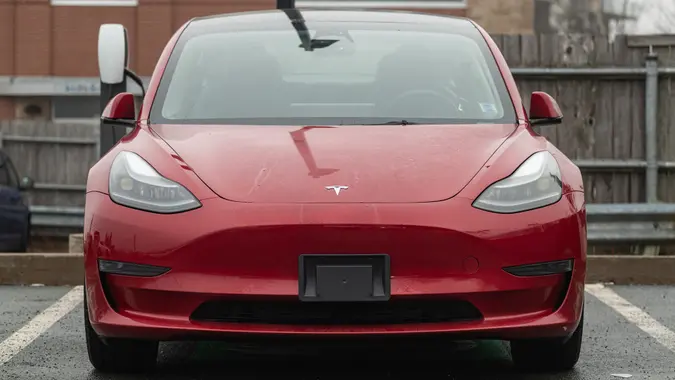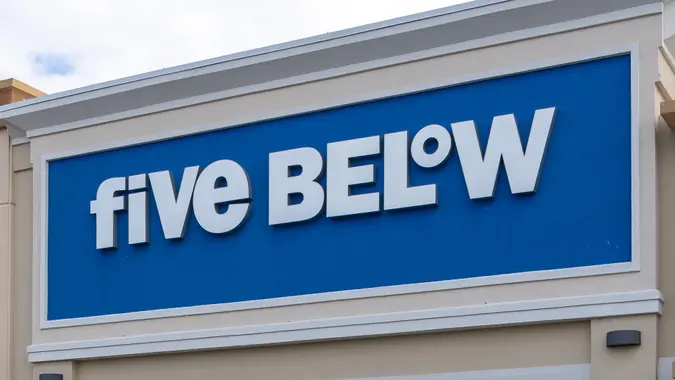7 Tips To Budget for Your Disney Trip Without Going Into Debt

Commitment to Our Readers
GOBankingRates' editorial team is committed to bringing you unbiased reviews and information. We use data-driven methodologies to evaluate financial products and services - our reviews and ratings are not influenced by advertisers. You can read more about our editorial guidelines and our products and services review methodology.

20 Years
Helping You Live Richer

Reviewed
by Experts

Trusted by
Millions of Readers
A trip to Disney can feel like stepping into a magical dream — until you check your bank account.
Between park tickets, hotel stays, meals shaped like Mickey Mouse, and the irresistible merch, costs can start to add up fast.
Even the New York Times reported how the pressure for families to create a once-in-a-lifetime experience at the theme park is placing them in debt.
But don’t worry — you can plan a Disney vacation without spiraling into debt.
“One thing that can really make a Disney trip affordable without going into debt is planning ahead and budgeting carefully,” said Adam Garcia, certified financial planner and founder of The Stock Dork.
Here are smart, doable tips to help you make the most of the magic without maxing out your credit card.
First, You Need a Solid Plan
According to Ashley Akin, CPA and senior contributor at Stock Screener Tips, planning a Disney trip is a big financial commitment, especially for families, but with a solid plan, you can absolutely avoid going into debt.
“I usually tell people to treat it the same way they would any major expense–budget early, automate savings, and be selective with where the money goes,” said Akin.
For example, a weekend trip for two adults can run anywhere between $1,300 and $2,500, while a full week for a family of four often hits the $7,000 to $11,000 range.
That’s everything bundled in — tickets, lodging, food, and transport.
While it sounds like a lot, Akin said it’s doable with a clear timeline. If you’re aiming for a $3,000 budget, set aside $500 a month for six months. For the higher end, she recommended planning for at least a year and breaking it into smaller weekly savings goals.
Know What’s Necessary, and What To Skip
Some expenses are worth the money, and others you can skip without feeling like you’re missing out.
“Park tickets are obviously non-negotiable, but you have room to optimize,” said Akin.
Multi-day tickets bring down the per-day cost — $76 a day if you go for seven days versus over $100 for single-day passes.
She said Genie+ is also worth it at certain parks like Magic Kingdom, where wait times are brutal.
“But the Park Hopper? I’d say skip it unless you’re doing a shorter trip and want to squeeze in a lot. You’ll save anywhere from $15 to $69 per ticket per day just by sticking to one park daily.”
Lodging Is Another Area Where It Pays To Compare
According to Akin, Value Resorts on Disney property start around $150 a night and sleep four, and you’ll still get perks like Early Entry.
But if you’re okay giving up those extras, off-site hotels can save you 30-50%. And here’s a fun workaround — if you’re a larger group, sometimes booking two value rooms is actually cheaper than getting a suite.
“That’s a detail most people miss.”
Food Adds Up Fast
A family of four will easily spend between $200 and $600 a day, depending on where they eat, said Akin.
Quick-service meals are generally more budget-friendly and still decent in terms of quality. You can also bring your own snacks and refillable water bottles to avoid buying overpriced drinks and snacks inside the parks.
It’s small stuff, but it adds up. She also doesn’t recommend the Disney Dining Plan unless you’re a big eater and plan on sitting down for more expensive meals every single day.
“Most people don’t come out ahead on that.”
Look Into Discounted Disney Gift Cards
To help clients save more efficiently, Akin often recommends discounted Disney gift cards from places like Sam’s Club or BJ’s.
She noted that you’ll typically get 3% to 4% off. While it doesn’t sound like a lot, it adds up: $500 in park expenses could cost you just $480 that way. Disney also lets you pay with just a $200 deposit and gives you until 30 days before your trip to settle the rest.
“That gives you structure to build a payment plan and automate savings — set it and forget it.”
Plan the Trip During Off-Peak Months
For families trying to keep it affordable, Akin usually recommends planning the trip during off-peak months like September — after the back-to-school rush but before the holiday crowds begin to roll in. Not only are hotel rates and flights often cheaper, but the parks themselves are less packed, which means shorter lines and a more relaxed experience overall.
If your schedule allows, avoid weekends and aim for mid-week visits. “Wednesdays are typically the cheapest days to visit the parks,” Akin added. “It might only be a $5 difference from Sunday on paper, but fewer crowds mean you can do more in one day, which gives you better value for your ticket.”
You’ll also likely save on food, Genie+ passes, and other time-saving upgrades simply because you won’t need them as much when the park isn’t at full capacity.
Break Your Budget Into Categories
If you want to get strategic, Akin recommended breaking your budget into categories — tickets, food, lodging, transport–and setting up separate savings “buckets” for each.
“That way, you’re not scrambling or guessing.”
Garcia also suggested a similar strategy. “We always recommend setting up a trip-specific fund and contributing regularly, which helps prevent impulse spending and keeps you aligned with your financial goals.”
By systematically saving a little at a time, he said, you ensure your dream vacation at Disney doesn’t turn into a financial nightmare.
And if you’re looking to splurge on something, do it on time-saving perks, not things like souvenirs. Merchandise in the park is marked up significantly. You’ll find the same items for a lot less online.
The Bottom Line
“Planning a trip is like planning a big family meal because saving early allows financial peace of mind, and it avoids unpleasant surprises when you’re having fun,” said Garcia.
In other words, the sooner you start planning and setting money aside, the more freedom you’ll have to actually enjoy the experience — without worrying about how you’ll pay for it later.
The moment you prioritize needs, like park tickets and lodging, before wants, like character dining or limited-edition souvenirs, is when your financial health stays intact.
Remember: A magical vacation doesn’t have to come with a scary credit card bill. With a little strategy, you can give yourself (and your wallet) the happy ending you deserve.
More From GOBankingRates
Sources:
- Adam Garcia, The Stock Dork
- Ashley Akin, Stock Screener Tips
Our in-house research team and on-site financial experts work together to create content that’s accurate, impartial, and up to date. We fact-check every single statistic, quote and fact using trusted primary resources to make sure the information we provide is correct. You can learn more about GOBankingRates’ processes and standards in our editorial policy.
 Written by
Written by  Edited by
Edited by 

























